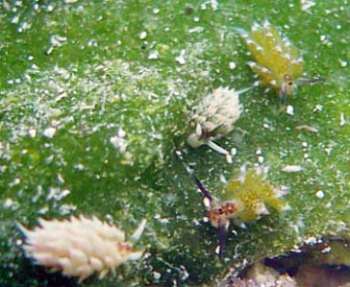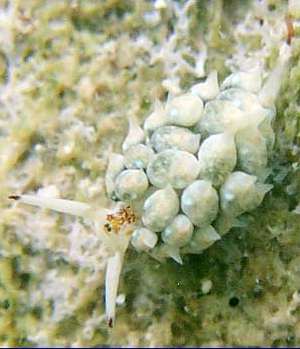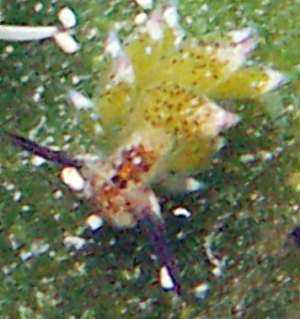Variation in Costasiella ?
January 20, 2006
From: Takao Urasawa

Hafa Adai Dr.Bill,
We wanna show you two kinds of sea slug. Are they the same - the eyes look different. Are they Costasiella kuroshimae, please ?
Locality: Eelgrass Beds, Saipan, Northern Mariana Islands, Pacific Ocean. Depth: 1.5 m. Length: 2 mm. 20 December 2005. on Avrainvillea obscura. Photographer: Takao Urasawa
dswith@isletwind.com


Dear Ura,
I am afraid there are some problems concerned with identifying species of Costasiella. I am afraid many of the species have been described from very few animals so we have little idea how variable they are in colour.
I suspect you have two species here. The paler animal in your lower left photo has only the tip of the rhinophores black, there are traces of blue spots on the cerata, and also traces of a yellowish band on the cerata as well. I suspect this animal is Costasiella kuroshimae. I can't see the characteristic thin yellow, or brownish yellow, median line from the eyes to the front of the head, but it may be the angle of the photo.
The green animal in your lower right photo is the same as the one I am calling Costasiella sp. 3. In that species the top half, or more, of each rhinophore is black, the ceratal wall is transparent, so the green of the digestive gland contents can be seen, and there are traces of the pinkish red patch near the tip of the cerata.
Of the four animal in your upper photo, I think the one near the centre is C. kuroshimae, and the other three are colour phases of Costasiella sp. 3. I may be wrong about the pale one at the bottom left of the photo, but I think it is one which hasn't fed for a while and so hasn't much green colouration.
This is all guesswork on my part, as we know so little about these animals. If you have the opportunity to see them often then why don't you try and see if you can find some way to sort them out? It is possible they have different egg ribbons, perhaps you can see different colour forms mating, etc etc. I suspect it will be people in the field who build up a good knowledge of the populations, who will find a clue to whether we have one, two, or many species. Radular differences are good when they are obviously different, but when differences in radular morphology are very subtle, they are no better than very subtle colour differences. My advice is for you to consider this not as an identification problem but as an opportunity to learn something new about these fascinating animals
Best wishes,
Bill Rudman
Related messages
-
Re: Costasiella formicaria from Japan
From: Kathe R. Jensen, July 22, 2008 -
Costasiella kuroshimae from Heron Island
From: Julie Marshall, April 12, 2005 -
Costasiella kuroshimae from Kerama Is.
From: Atsushi Ono, May 29, 2002
